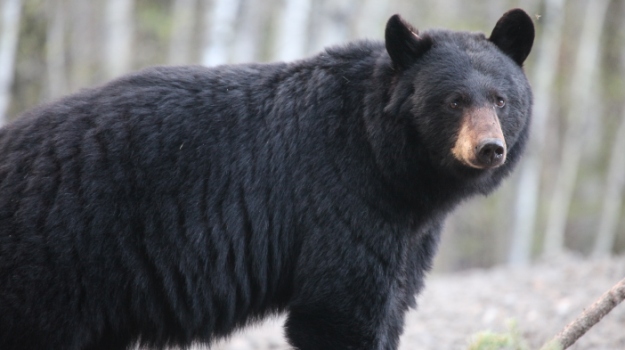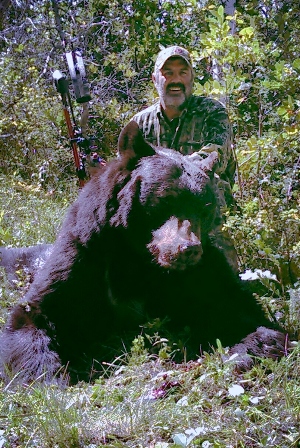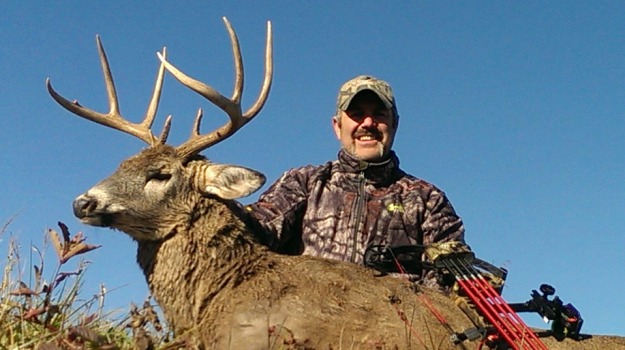
Editor’s Note: Mike Magrew of O’Fallon, Missouri, is Mossy Oak’s whitetail regional ProStaff manager for Illinois, Missouri and Kansas and has been hunting whitetails for 35 years.
When I don’t draw a special tag to hunt in Colorado, I buy over-the-counter tags. A few seasons ago I went to Colorado with an elk archery tag and black bear archery tag. On the opening day of archery season, I decided to hunt a drainage I had hunted before where I knew there were big bears and big bull elk. In the bottom of the drainage were plenty of berries and thick-cover areas where the bears could hide and bed. I started still hunting (stalking) up the drainage, and I probably had only gone 1/2-mile when I spooked a bull elk. I never saw the bull, but I heard him get up out of the cover. Later, I found his tracks. I really thought I had ruined my hunt.
 However, I decided to keep going, take my time and move as slowly as possible. I was stalking up a very-small trail that went through some thick cover. When I heard a noise, I thought, “If there's a critter coming this way, he's probably going to be on this trail.” But the trail was the only way I could move through that thick cover without making noise. As soon as I heard the noise, I stopped, looked up the trail and spotted a squirrel in a pine tree. Although I reasoned that the squirrel must have been the critter making the noise, I decided to stay still and wait to see what happened next. I already had raised my foot to take a step and start moving again when I looked up the trail and spotted a bear under the pine tree where I had seen the squirrel. I waited to make sure that this bear wasn’t a sow and didn’t have cubs.
However, I decided to keep going, take my time and move as slowly as possible. I was stalking up a very-small trail that went through some thick cover. When I heard a noise, I thought, “If there's a critter coming this way, he's probably going to be on this trail.” But the trail was the only way I could move through that thick cover without making noise. As soon as I heard the noise, I stopped, looked up the trail and spotted a squirrel in a pine tree. Although I reasoned that the squirrel must have been the critter making the noise, I decided to stay still and wait to see what happened next. I already had raised my foot to take a step and start moving again when I looked up the trail and spotted a bear under the pine tree where I had seen the squirrel. I waited to make sure that this bear wasn’t a sow and didn’t have cubs.
Then, I took a few steps off the trail. The bear was working himself through the brush. When he went behind some very-thick brush, I drew my bow. I don’t know if he heard me as I drew or what. I knew he heard some sound, because when I drew my bow, he stopped. I was at full draw. I started wondering, “How long can I stay at full draw before I have to let down?” In a few more seconds, he took another step or two and peeked around some thin brush with his side touching the brush. If I took the shot, I knew that the broadhead could push through the brush and hit the bear. I squeezed the trigger on my mechanical release and in less than an eye blink, the arrow hit the mark right behind the bear’s front shoulder and went out of sight. Instantly, I knew I had a double lung shot. The bear growled and took off running. When the bear had covered about 30 yards, I could hear him thrashing around, even though he was out of sight.
I never was concerned about my own personal safety until after the shot. But when I paced off the distance and realized that the bear had only been 17 yards from me when I released the arrow, I got shook up. I’ll be honest. My nerves were rattled. I had no problem waiting for 30 minutes before I went to look for the bear. I studied my arrow. I made sure that I’d gotten a complete pass-through and was convinced that I had made a really good hit. However, walking up to a bear in thick cover and not knowing exactly where he was helped convince me to wait before attempting to find the bear by myself.
Once I finally saw my bear, I couldn’t believe how big he was - about a 350 pounder. I field dressed my bear and opened him up, so the meat could cool. I hiked back to camp and got my pack and my hunting buddy. We went back, butchered the bear and carried the meat, the head and the hide out about 3/4-mile. Because we had big packs, we only had to make one trip from where I’d taken the bear back to camp. However, that last 1/4-mile I realized we would have been better off if we had made two trips to get the animal out. If I ever take another bear that size, I won’t try to get him out in one trip with just me and another hunter.
Day 3: A Buck Deer at My Back
Tomorrow: Taking Public Land Colorado Elk






























